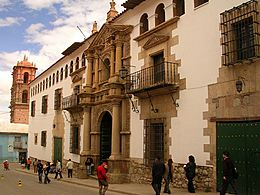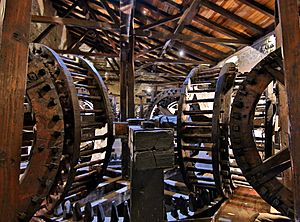National Mint of Bolivia facts for kids
Quick facts for kids National Mint of Bolivia |
|
|---|---|

Façade of the Mint, February 2007
|
|
| General information | |
| Location | Potosí, Bolivia |
| Opened | 1572 |
| Design and construction | |
| Architect | Jerónimo Leto |
The National Mint of Bolivia is a famous old building in Potosí, Bolivia. It's also known as the Mint of Potosí. A mint is a place where money, like coins, is made.
This mint was super important long ago. It made most of the silver coins that traveled across the world. These coins were called Spanish dollars. They became a major currency during the time of the Spanish Empire.
Today, the building is a museum. It stands where the second colonial mint used to be. That mint operated from 1773 until 1951. The coins made here were so famous that people had a saying. Miguel de Cervantes even wrote about it. The saying was valer un potosí, meaning "to be worth a fortune."
Contents
The First Mint: Making Money in Potosí
Potosí had a huge silver mountain called Cerro Rico. Because of all the silver, the city grew very fast. More people and more trade meant they needed a place to make coins. So, a mint was necessary.
Coin making started in 1572. The first methods were quite basic. This simple way of making coins lasted for a long time. It was used for 212 years, from 1572 to 1767.
The Spanish viceroy, Francisco de Toledo, Count of Oropesa, suggested building the first mint. Construction began in 1572. It was built near the Royal Palaces in the Plaza del Regozijo. This area is now called Plaza 10 de Noviembre.
The architect Jerónimo Leto finished the work in three years. The building cost a lot of money. It was more than 8,000 pesos. That's like ten million dollars today! It's said that Charles III of Spain heard the cost. He joked that "the whole building must be made of pure silver."
The Second Mint: New Ways to Make Coins
After some problems and an investigation, plans to fix the old mint were dropped. Instead, a brand new building was put up. It was built in the nearby plaza del Gato.
Construction on this new mint started in 1757. It was finished in 1770, even with many challenges. The old way of making coins was called Hammered coinage. This meant placing a metal blank between two dies. Then, workers would hit the top die with a hammer. This made the image appear on both sides of the coin.
This hammering method continued at the old factory until 1773. However, the first coins made with a screw-press machine were produced in 1767. These machines were used until 1869. That's when modern steam presses were installed.
The Casa de la Moneda museum you can visit today is located at the site of this second mint.
Later Years: From Revolution to Museum
In 1813, revolutionary leaders took over the Casa de Moneda. General Manuel Belgrano led this change. Days before, a new national currency was created for the United Provinces of the Río de la Plata.
The Potosí Mint then made gold coins and silver coins. These coins no longer had the King of Spain's face. Instead, they said "In Union and Liberty." One side showed a shining Sun of May. The other side had the coat of arms of Argentina. The coins also had "United Provinces of the Río de la Plata" and "PTS" for Potosí. In 1815, the coin-making tools were moved to Córdoba. This became the first mint in Argentina.
The Republic of Bolivia was formed on August 6, 1825. After 15 years of conflict, with help from Simón Bolívar and Antonio José de Sucre, Bolivia set up its own money system. It took two years for the first Bolivian coins to be made. Spanish money was still used during that time.
In 1933, the old Mint building was used as a headquarters. This was during the Chaco War. This war was fought between Bolivia and Paraguay. Later, the building was even used as a stable for farmers' animals.
The mint at the site of the second colonial building made its last coin in 1951. Now, it is a very important museum in Bolivia. The building is part of the UNESCO World Heritage status for the City of Potosí, recognized in 1987.
See also
 In Spanish: Casa de la Moneda de Bolivia para niños
In Spanish: Casa de la Moneda de Bolivia para niños
- Great Potosi Mint Fraud of 1649


